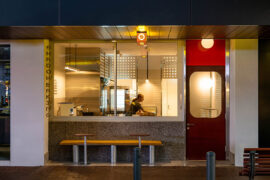The reimagining of All Saints Estate by Technē includes new architecture and sensitive interiors for a multifaceted hospitality offering at the regional winery.

February 19th, 2024
All Saints Estate, with a cellar door dating back to around 1884, is Technē’s very first winery project. The task of balancing old with new, heritage with contemporary, is one for which the practice has already established a strong reputation, just as it has with regional projects.
“Our decision to engage Technē was a very considered one,” says All Saints Estate director, Eliza Brown. “As we were working with a heritage-listed building, we needed a firm that could rise to the challenging brief and reimagine the building without losing the authenticity of the existing castle facade. It was vital to acknowledge this history in a considered manner while also creating a world-class tourism experience.”
The history side of things here on the banks of the Murray River in Wahgunyah, Victoria, is very much dominated by the castle set there originally by Scottish founders. Responsible for all aspects of the design – architecture and interiors – Technē has taken cues from and paid homage to the castle in various ways.
Externally, a new restaurant, KIN, sits within an extension which connects to the existing structure with lightness. Technē associate director, Sam Sempill, explains further: “The extension is juxtaposed against the original heritage building, and is slightly oriented away from the castle, facing towards the lake and the vines. This orientation reflects a new direction for the business whilst maintaining its historic links to the castellated building.

“Its connection by a glazed link and lounge area to the original building, and to the [cellar door eatery] Bonnie via a steel-covered walkway outside, creates an enduring connection to the estate’s rich architectural history and the family’s ties to its past as it moves into the future.”
Materially, the dialogue continues between what was already there and what has been added. The palette of texturally rich materials includes exposed red brick, charred timber, charcoal aluminium cladding and steel. The brick walls carry into the interior, meeting touches of blackened steel, ceramic and stone, all paired with lighter timbers and furnishings, fluted timber bar faces and flowing linen fabrics.
Related: RACV Healesville Country Club also by Technē

“Naturally, the early stages of our design response considered the site’s history, its location and orientation,” says Technē director, Nick Travers. “To transform these initial ideas into an innovative bespoke design, however, we were entrusted with the time and space for this process. Ultimately, the final design interprets their needs through our design lens and enabled us to create something surprising and unique for them – framing an apt reflection of our desire to make poetically.”
Back inside the original building, Bonnie is the new artisanal eatery created as part of the refurbishment of the heritage spaces. Its name, alongside tartan accents and a colour palette of deep blues, reds and greens, pays tribute to the Scottish history here at Rutherglen. Meanwhile, in terms of form, a playful language of curves is used throughout and at varying scales including furniture design and selection, as well as the external dining room walls and booth seating designed evoke the ubiquitous wine barrels on-site.

Features such as kiln-fired fixtures further add to the historical narrative, while the estate’s Elm trees – more than a century old – have inspired the repeated vertical geometries found in the shelving and tiling. The surrounding landscape is then embraced again through new apertures for light and views, with large windows and sliding doors allowing for space to be fully opened up. Circular skylights also generously add new light to previously darkened interior spaces.
Technē’s approach to the whole project is defined by the balancing of old and new, but not always in the same way. Sometimes it’s through the juxtaposition of solidity and lightness, for example, while elsewhere it’s about more subtle colour or material choices. It all makes for a fine regional winery, rich with landscape beauty and a new architecture.
Technē Architecture and Interior Design
techne.com.au
Photography
Tom Blachford







INDESIGN is on instagram
Follow @indesignlive
A searchable and comprehensive guide for specifying leading products and their suppliers
Keep up to date with the latest and greatest from our industry BFF's!

In an industry where design intent is often diluted by value management and procurement pressures, Klaro Industrial Design positions manufacturing as a creative ally – allowing commercial interior designers to deliver unique pieces aligned to the project’s original vision.

Merging two hotel identities in one landmark development, Hotel Indigo and Holiday Inn Little Collins capture the spirit of Melbourne through Buchan’s narrative-driven design – elevated by GROHE’s signature craftsmanship.

In an industry where design intent is often diluted by value management and procurement pressures, Klaro Industrial Design positions manufacturing as a creative ally – allowing commercial interior designers to deliver unique pieces aligned to the project’s original vision.

Working within a narrow, linear tenancy, Sans Arc has reconfigured the traditional circulation pathway, giving customers a front row seat to the theatre of Shadow Baking.

At the Munarra Centre for Regional Excellence on Yorta Yorta Country in Victoria, ARM Architecture and Milliken use PrintWorks™ technology to translate First Nations narratives into a layered, community-led floorscape.

The Simple Living Passage marks the final project in the Simple World series by Jenchieh Hung + Kulthida Songkittipakdee of HAS design and research, transforming a retail walkway in Hefei into a reflective public space shaped by timber and movement.
The internet never sleeps! Here's the stuff you might have missed

At the National Wool Museum, a new exhibition traces the evolution of Godfrey Hirst and its long-standing role in shaping Geelong’s industrial and design identity.

A research exhibition reimagines St Kilda’s civic spaces through soft infrastructures that enhance wellbeing and urban experience.